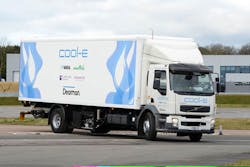Zero-emission reefer system delivers some cool results
A revolutionary zero-emission refrigeration system for transportation applications, developed in the United Kingdom, that delivers both power and cooling from liquid nitrogen, has begun on-vehicle testing.
This system, which features a liquid nitrogen-powered Dearman engine, has already produced promising results and could deliver a paradigm shift within the global transport refrigeration industry.
The Dearman system is being tested as part of an Innovate UK-backed project—called Cool-E—managed by a consortium of MIRA, Dearman, Air Products, and Loughborough University.
This liquid nitrogen-powered technology has been developed as a zero-emission alternative to fossil-fueled transport refrigeration units, which can emit up to six times as much nitrogen oxide (NOx) and 29 times as many particulates as a Euro 6 diesel engine.
A program of on-vehicle testing has begun and will continue through summer 2015, but initial test results indicate the system already can cool the chilled trailer more quickly than a conventional diesel refrigeration unit. Most importantly, initial testing has served to validate the principles behind the system, demonstrating that it can successfully provide a zero-emission alternative to conventional cooling equipment.
Toby Peters, founder and senior group managing director of Dearman, said, “This is a key moment in the development of cutting-edge, zero-emission clean cold and power technology. With the global demand for cooling, and transport refrigeration, in particular, growing extremely rapidly, we are faced with an environmental challenge—but also an economic opportunity. The fact that our system is running, and that it has already delivered very promising results, highlights the role that Dearman technology can play in meeting the inescapable need for sustainable cooling.”
Dr Andy Williams at Loughborough University said, “Cold energy stores such as liquid nitrogen or liquid air have over 10 times the cooling capacity than the heat they can absorb. It is exciting to see the Dearman engine enabling access to this extra cooling power within the Cool-E project, paving the way for future cold energy technologies.”
A significant increase in demand for transport refrigeration is predicted to occur in the years ahead. Globally, the number of transport refrigeration units on the road is expected to increase rapidly, to at least 9.6 million.
This zero-emission system has the potential to displace a significant amount of diesel that would otherwise be used to meet that growing need. A transport refrigeration unit accounts for up to 20% of the vehicle’s total diesel usage, so moving to a zero-emission technology will have major environmental benefits—reducing air pollution and delivering well-to-wheel CO2 savings—while allowing operators to save operational costs per vehicle each year.
Building on the Cool-E project, the first Dearman engine-powered transport refrigeration unit is expected to go into commercial field trial later in 2015, with larger-scale European and international trials to begin in 2016.
For more information, contact Eric B Trachtenberg at 202-536-1101 or email [email protected].
